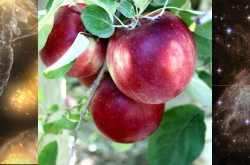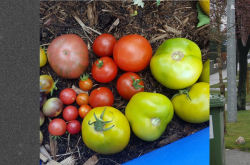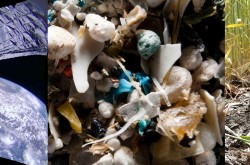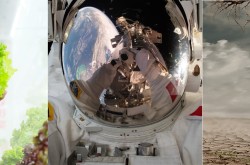3 things you should know — November edition


Meet Renée-Claude Goulet, Jesse Rogerson, and Michelle Campbell Mekarski.
They are Ingenium’s science advisors, providing expert scientific advice on key subjects relating to our three museums — the Canada Agriculture and Food Museum, the Canada Aviation and Space Museum, and the Canada Science and Technology Museum.
In this colourful monthly blog series, Ingenium’s science advisors offer up three quirky nuggets related to their areas of expertise. For the November edition, they took a closer look at indoor composting, Saturn’s newly-discovered moons, and the brain science behind “comforting” smells.

Indoor composting is a thing!
As cities strive to reduce the amount of waste sent to landfills, many have implemented curbside compost collecting programs. But people who live in apartments may find it more difficult to compost than people living in detached housing.
Green bin services are not typically available in apartment buildings or condos. Plus, the design and architecture of multi-dwelling housing is often ill-fitted to the messy business of compost collection.
But there is an alternative: team up with worms and turn your food scraps into fertilizer — right in your own home! This is a practise known as vermicomposting.
The fear of a stinky, rotting mess may spring to mind — but vermicomposting is far from that! The experience is more akin to keeping a very low maintenance pet. In this case, it’s like a super-being — made up of thousands of other organisms; it’s a complex ecosystem and a living, food-waste processing, fertilizer-making machine!
A vermicomposter is comprised of stacking, perforated bins. Red wriggler worms — small, surface-dwelling earthworms that can eat half their weight every day — inhabit the bin with organisms like mites, springtails, fungi, protozoa, and bacteria. The living community of earth worms and microbes will effectively decompose fruit and vegetable scraps, paper towels, napkins, paper, and egg cartons, without any bad odours or insect pests.
The result is vermicast, which is a black, soil-like substance. You can use it in many ways: make compost tea to water plants with, mix it with potting soil or seed-starting mix, or simply dump it outside in a garden.
You can assemble one yourself, or even purchase one pre-assembled! There are a multitude of webpages and videos to help you get started. To find the right worms, you may need to do a quick search in your local online classified ads. Maintaining a worm farm can be an interesting and fun adventure, all while helping you reduce the amount of food scraps going in the trash!
By Renée-Claude Goulet

The 20 new moons of Saturn fall into 3 different groups of previously known moons.
New satellites of Saturn
The Carnegie Institute for Science recently announced the discovery of 20 previously unobserved moons orbiting Saturn. Twenty! That’s a lot of moons! This brings Saturn’s total moon count to 82, which makes it the planet in our Solar System with the most moons.
These new moons — known scientifically as satellites — are all very small. Each moon is likely less than five kilometres in size, and orbit between 15 and 25 million kilometres from Saturn (for scale, our Moon is only 386,000 km from Earth). The new moons are also members of already-known groups of moons that orbit Saturn: the Inuit group, the Gallic group, and the Norse group. The moons in these groups share similar orbital characteristics, like distance from Saturn and orbital inclination.
The interesting thing is that these 20 moons were discovered in images taken back in 2004 and 2005 using the Subaru Telescope, during a previous search for moons around Saturn. Last summer, the team of scientists went back to the old data and found even more moons!
But the best part of this story is that the Carnegie Institute has started an open Twitter contest, under the handle @SaturnLunacy, to name the new moons! Anyone from around the world can suggest names, and the International Astronomical Union — the group that officially names objects in the Solar System — will use the suggestions from the Twitter contest. But you can’t just name it after yourself; there are rules. The names must follow the conventions already in place for moons of those groups. For example, moons in the Norse group must be named after giants from Norse mythology. There are other rules/conventions to follow as well, so check out the contest rules and information. Maybe you can help name a moon in our Solar System!
By Jesse Rogerson

The smells of the fall
Pumpkin spice and everything nice...that’s what our brains are telling us
Picture a quintessential fall scene: cool air, colourful leaves, the smell of spice in the air. Which spice? Pumpkin spice, of course! Lattes, donuts, nuts, chocolates, cereal, pasta sauce, candles, and even air fresheners. Have you taken a deep whiff lately? It’s pumpkin spice season.
According to Starbucks, over 200 million pumpkin spice lattes (PSLs if you’re on social media) have sold since it was introduced in 2003, and now it seems like every other store is selling pumpkin spice something. Pumpkins don’t seem to get a lot of love the rest of the year, so what’s with the annual fall obsession?
Turns out, it has a lot to do with how your brain processes your senses, specifically, your sense of smell. When you sense anything, it is the result of some kind of stimulus activating sensory nerves, which carry a signal to your brain. Most of your senses — sight, taste, touch, sight — go through a region in your brain called the thalamus, which acts a bit like a relay station. For instance, visual information might be sent to regions of your brain responsible for recognizing visual patterns (reading), or for planning for your next movement. Nerves coming from the smell receptors in your nose skip the thalamus. Instead, incoming signals pass directly to several regions of your brain including the amygdala — which controls emotion — and the hippocampus, which is involved with memory formation and emotions.
This means that smell is very tightly linked with memories and emotions. If you smell lemons during a happy moment, then smelling lemons in future will bring back the happy emotions and memories from that time. Perfume and cologne developers take advantage of this neural-nostalgia and are always on the ‘scent’ for smells that make people feel powerful, relaxed, or sensual.
Pumpkin spice — or more specifically the blend of cinnamon, nutmeg, cloves, ginger, and other spices — are smells that are typically associated with the warmth and coziness of fall and winter holidays like Thanksgiving and Christmas, particularly in North America. So, in your brain, the familiar smells of pumpkin spice will evoke memories and emotions of holidays, family time, home baking, visiting pumpkin patches, parties, and feasts.
The pumpkin spice craze isn’t going anywhere. As long as the smell carries warm and happy memories, pumpkin spice will continue to bring a little fall coziness to the brain. So keep on sipping the feels!
By Michelle Campbell Mekarski
Looking to read more quirky science nuggets? Check out the “3 things you should know” Board.











